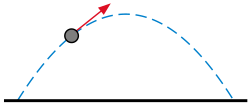
A | B | C | D | E | F | G | H | CH | I | J | K | L | M | N | O | P | Q | R | S | T | U | V | W | X | Y | Z | 0 | 1 | 2 | 3 | 4 | 5 | 6 | 7 | 8 | 9

| Differential equations |
|---|
| Scope |
| Classification |
| Solution |
| People |
In mathematics, an ordinary differential equation (ODE) is a differential equation (DE) dependent on only a single independent variable. As with other DE, its unknown(s) consists of one (or more) function(s) and involves the derivatives of those functions.[1] The term "ordinary" is used in contrast with partial differential equations (PDEs) which may be with respect to more than one independent variable,[2] and, less commonly, in contrast with stochastic differential equations (SDEs) where the progression is random.[3]
Differential equations
A linear differential equation is a differential equation that is defined by a linear polynomial in the unknown function and its derivatives, that is an equation of the form
where , ..., and are arbitrary differentiable functions that do not need to be linear, and are the successive derivatives of the unknown function y of the variable x.
Among ordinary differential equations, linear differential equations play a prominent role for several reasons. Most elementary and special functions that are encountered in physics and applied mathematics are solutions of linear differential equations (see Holonomic function). When physical phenomena are modeled with non-linear equations, they are generally approximated by linear differential equations for an easier solution. The few non-linear ODEs that can be solved explicitly are generally solved by transforming the equation into an equivalent linear ODE (see, for example Riccati equation).
Some ODEs can be solved explicitly in terms of known functions and integrals. When that is not possible, the equation for computing the Taylor series of the solutions may be useful. For applied problems, numerical methods for ordinary differential equations can supply an approximation of the solution.
Background
Ordinary differential equations (ODEs) arise in many contexts of mathematics and social and natural sciences. Mathematical descriptions of change use differentials and derivatives. Various differentials, derivatives, and functions become related via equations, such that a differential equation is a result that describes dynamically changing phenomena, evolution, and variation. Often, quantities are defined as the rate of change of other quantities (for example, derivatives of displacement with respect to time), or gradients of quantities, which is how they enter differential equations.[citation needed]
Specific mathematical fields include geometry and analytical mechanics. Scientific fields include much of physics and astronomy (celestial mechanics), meteorology (weather modeling), chemistry (reaction rates),[4] biology (infectious diseases, genetic variation), ecology and population modeling (population competition), economics (stock trends, interest rates and the market equilibrium price changes).
Many mathematicians have studied differential equations and contributed to the field, including Newton, Leibniz, the Bernoulli family, Riccati, Clairaut, d'Alembert, and Euler.
A simple example is Newton's second law of motion—the relationship between the displacement x and the time t of an object under the force F, is given by the differential equation
which constrains the motion of a particle of constant mass m. In general, F is a function of the position x(t) of the particle at time t. The unknown function x(t) appears on both sides of the differential equation, and is indicated in the notation F(x(t)).[5][6][7][8]
Definitions
In what follows, y is a dependent variable representing an unknown function y = f(x) of the independent variable x. The notation for differentiation varies depending upon the author and upon which notation is most useful for the task at hand. In this context, the Leibniz's notation (dy/dx, d2y/dx2, …, dny/dxn) is more useful for differentiation and integration, whereas Lagrange's notation (y′, y′′, …, y(n)) is more useful for representing higher-order derivatives compactly, and Newton's notation is often used in physics for representing derivatives of low order with respect to time.
General definition
Given F, a function of x, y, and derivatives of y. Then an equation of the form
is called an explicit ordinary differential equation of order n.[9][10]
More generally, an implicit ordinary differential equation of order n takes the form:[11]
There are further classifications:
- Autonomous
- A differential is autonomous if it does not depend on the variable x.
- Linear
-
A differential equation is linear if can be written as a linear combination of the derivatives of y; that is, it can be rewritten as
- Homogeneous
- A linear differential equation is homogeneous if r(x) = 0. In this case, there is always the "trivial solution" y = 0.
- Nonhomogeneous (or inhomogeneous)
- A linear differential equation is nonhomogeneous if r(x) ≠ 0.
- Non-linear
- A differential equation that is not linear.
System of ODEs
A number of coupled differential equations form a system of equations. If y is a vector whose elements are functions; y(x) = , and F is a vector-valued function of y and its derivatives, then
Antropológia
Aplikované vedy
Bibliometria
Dejiny vedy
Encyklopédie
Filozofia vedy
Forenzné vedy
Humanitné vedy
Knižničná veda
Kryogenika
Kryptológia
Kulturológia
Literárna veda
Medzidisciplinárne oblasti
Metódy kvantitatívnej analýzy
Metavedy
Metodika
Text je dostupný za podmienok Creative
Commons Attribution/Share-Alike License 3.0 Unported; prípadne za ďalších
podmienok.
Podrobnejšie informácie nájdete na stránke Podmienky
použitia.
www.astronomia.sk | www.biologia.sk | www.botanika.sk | www.dejiny.sk | www.economy.sk | www.elektrotechnika.sk | www.estetika.sk | www.farmakologia.sk | www.filozofia.sk | Fyzika | www.futurologia.sk | www.genetika.sk | www.chemia.sk | www.lingvistika.sk | www.politologia.sk | www.psychologia.sk | www.sexuologia.sk | www.sociologia.sk | www.veda.sk I www.zoologia.sk











